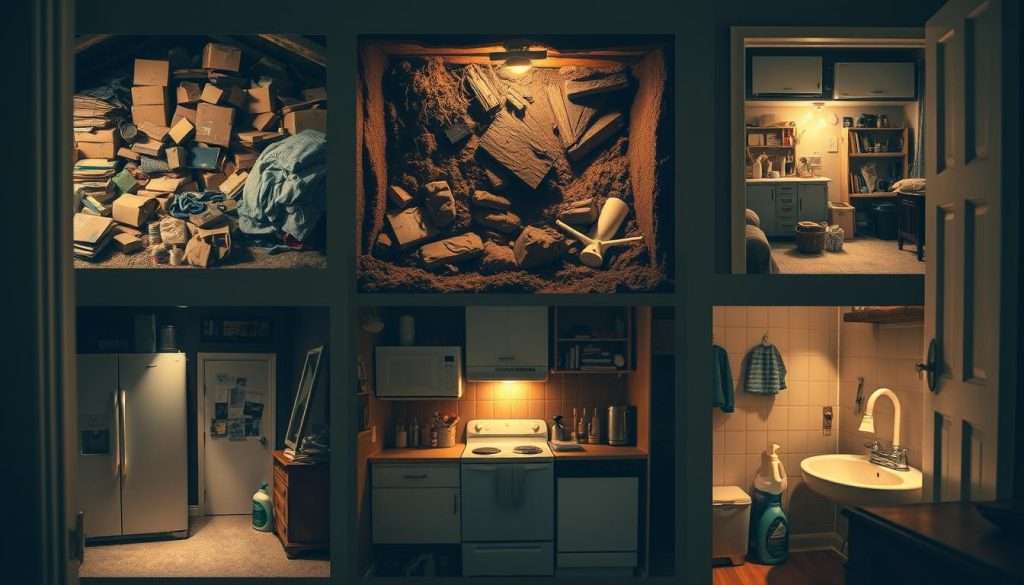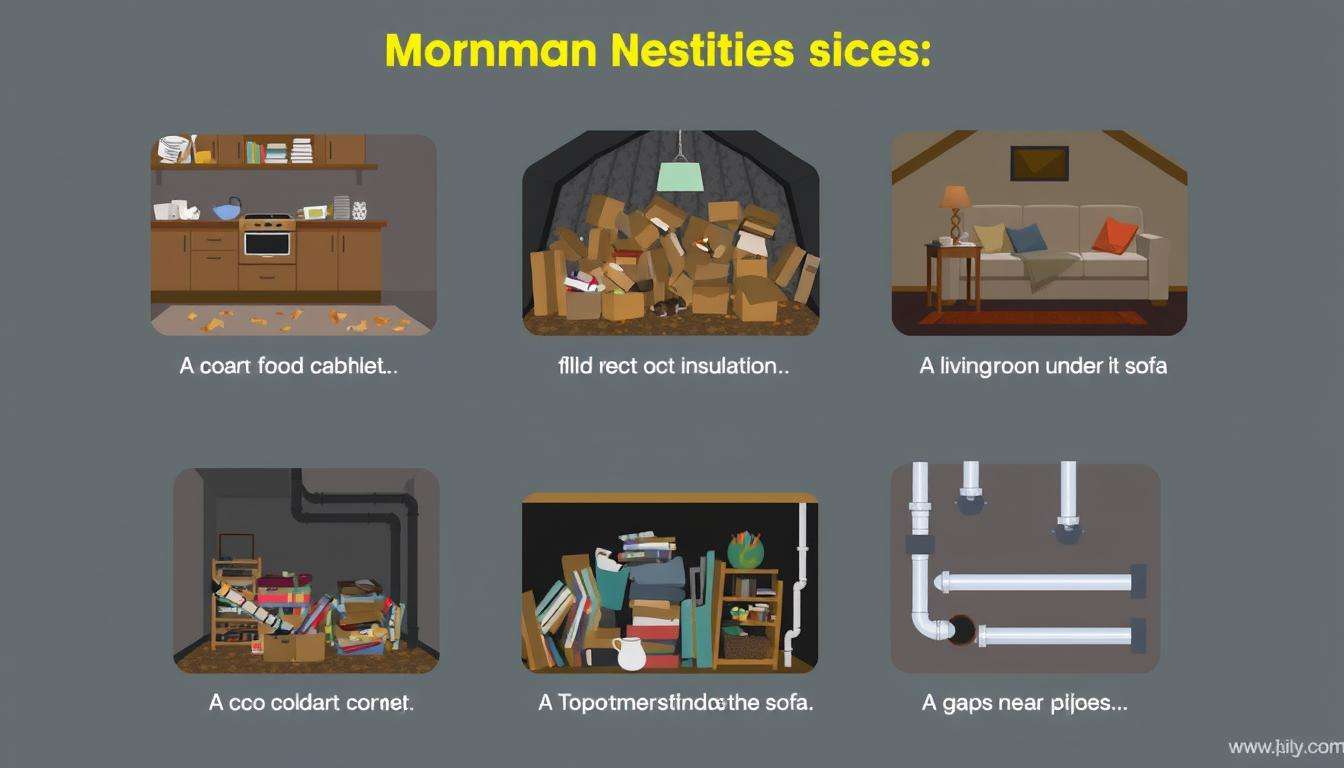Mice are experts at making themselves at home. They nest in many common places inside our homes. Knowing where mice nest is key to keeping your home rodent-free.
The kitchen is a favorite spot for mice. It’s warm and full of food. They like to nest near food, usually within 30 feet.
Some common places mice nest include:
- Pan drawer under the stove
- Behind or under the refrigerator
- Inside appliances’ insulation
- Lower kitchen cabinets, especially in corners
- Behind kick plates of cabinets
- In pantry or utility closet corners
Mice make nests from soft things like shredded paper and fabric. They also use food and droppings. They like dark, quiet spots like furniture stuffing and wall voids.
Key Takeaways
- Mice often nest in the kitchen due to easy access to food.
- Nests are typically close to food sources, no further than 30 feet away.
- Common nesting sites include hidden areas like pan drawers and behind appliances.
- Mice create nests from soft materials, which may include food remnants.
- They also favor dark, undisturbed spaces for nesting.
- A single nest can harbor a dozen to two dozen mice.
- Understanding nesting behavior is key to effective rodent control.
Understanding Mice Nesting Behavior
Mice have instincts that guide their mouse nesting behavior. They look for places with food and safe shelter. Kitchens are often their favorite spots because of the food.
They make 15 to 20 trips to food sites each day. This helps them find the best places to eat.
Mice like warm, dark, and narrow spots for their nests. They often choose crawlspaces, attics, and hidden furniture. Garages, kitchens, basements, and under car hoods are also popular spots.
Knowing these habits helps you find where mice might nest in your home.
Ignoring a mouse nest can lead to a big problem. A single nest can grow to hundreds of mice in a few months. Mice breed fast, with females having up to six pups per litter and up to eight litters a year.
So, it’s important to find and deal with nesting sites early to prevent infestations.
To learn more about where mice nest, check out this article on identifying mice nesting spots. Knowing about mouse behavior helps prevent problems and keeps your home safe and healthy.
Common Indoor Nesting Sites for Mice
Knowing where mice like to nest indoors can help you stop them before they start. Mice look for warm places and food in your home. Learning about mice nesting locations in homes helps keep your home mouse-free.
The Kitchen as a Primary Nest Site
The kitchen is a top spot for mice because of the food. Look closely at:
- Under appliances, such as refrigerators and stoves
- Inside drawers and cabinets, especially near food
- In the backs of pantries, where it’s dark and safe
Mice like dark spots close to food. This makes kitchens a common place for them. Keeping these house areas prone to mouse nesting clean is very important.
Other Common Areas in the Home
Other places in your home can also attract mice. Check these spots often:
- Closets, especially those storing seasonal items
- Attics and crawl spaces, where it’s quiet
- Garages filled with clutter, offering hiding spots
- Behind furniture, where mice can hide

Knowing where mice nest helps you stay alert. Keeping your home clean in these areas can keep mice away. Taking action now keeps your home safe and comfortable.
Where Do Mice Nest in House?
Learning about mice nesting habits helps us find where they live in our homes. By watching their behavior, we can stop them from making themselves at home.
Analyzing Areas Near Food Sources
Mice like places close to food. They nest near food to survive. Look for nests in:
- Closets
- Kitchens, especially near pet food and crumbs
- Pantries, where food is easy to find
- Garages or sheds, with open containers or loose items
Spotting where mice nest can be tricky. But, they usually stay within 30 feet of food. Look in corners and between appliances.
Identifying Quiet and Enclosed Spaces
Mice prefer quiet, hidden spots for safety. They nest in:
- Attics, for warmth and shelter
- Basements and crawl spaces, which are often quiet
- Wall voids, for hiding
- Under kitchen sinks and in cabinets, for extra cover
Searching these hidden spots helps find where mice nest. Sealing entry points can keep them out.
Signs of Mice Nests Indoors
Knowing the signs of mice nests indoors is key to acting fast. Spotting where mice nest means looking for certain signs. If you ignore these signs, problems can grow. So, let’s look at some important signs.
Recognizing Droppings and Shredded Materials
Mouse droppings are a clear sign they’re around. They’re small, about 3 to 6 mm long and round. You can find them in places like:
- Pantry items
- Corners
- Drawers
- Cupboards
- Under sinks
- Behind toilets
Also, look for shredded stuff. Mice use it to make their nests. They might use ripped clothes, insulation, or food wrappers.
Understanding Mouse Odors and Sounds
Bad smells can mean mice are around. Mouse pee smells like ammonia, especially in the morning. Sounds like scurrying or scratching in walls mean mice are nearby.
Spotting Nesting Locations
Finding where mice nest is important to fix mold problems. They often nest in:
- Attics
- Basements
- Kitchens
- Crawl spaces
- Behind appliances
Nests look like small piles or balls of shredded stuff, about 3 to 6 inches big. They’re in dark, quiet spots with one entrance. Knowing these signs helps you deal with the problem.
How to Find Mouse Nests Inside
To find mouse nests inside your home, start by looking for signs of activity. Look for droppings, shredded materials, and mice sightings. These signs show where mouse nests might be.
Mice like to nest in dark, secluded spaces near heat sources. Check these spots:
- Wall voids
- Underneath appliances
- Inside cabinets
- Behind furniture
- Suspended ceilings
- Voids inside appliances like stoves
Listen for scratching noises to find hidden nests. Mice are mostly active at night. But, they might be seen during the day. Use a flashlight to see better in dark spots.
Act fast if you find signs of mouse nests. Quick action can stop bigger problems. It keeps your home safe and clean.
Detecting Mouse Nest Presence in Your Home
Finding mouse nests in your home needs watching and taking steps ahead. Spotting signs early helps avoid damage and discomfort. There are many ways to find nests well.
Common Techniques for Identification
Look for these signs to see if mice are around:
- Droppings near food or in secret spots.
- Shredded stuff like fabric or paper for nests.
- Gnaw marks on furniture, walls, or wires.
- Strange sounds, especially at night, showing mouse activity.
Checking attics and basements often is smart. Mice often nest there. Using thermal cameras and ultrasonic detectors helps find hidden spots and mice.
Tips for Maintaining a Mouse-Free Environment
Keeping your home mouse-free is key for safety and comfort. Here are some good tips:
- Seal holes with steel wool and caulking.
- Fix cracks in the foundation and around windows and doors.
- Keep food in tight containers to stop mice from finding it.
- Fix water leaks fast, especially in basements.
- Watch closely and check often for mouse signs.
Following these tips for maintaining a mouse-free environment helps a lot. It keeps your home safe and comfy. Always be ready to act fast to stop mice from coming back.

Conclusion
We’ve looked into where mice nest in houses. It’s key to know where they like to hide. Mice are not just pests; they can damage your home and health.
Adult mice can squeeze through tiny gaps. So, it’s important to check your whole house for where they might get in.
Knowing the signs of mice helps you act fast. Look for droppings that look like rice and musky smells. These signs mean mice might be around.
House mice can make big nests and store food. This can make your kitchen dirty. Keep an eye out for these signs to keep your home clean and safe.
To fight mice, seal up holes and keep your home clean. If you need help, get a professional. Learn more about mouse habits and how to stop them here.
